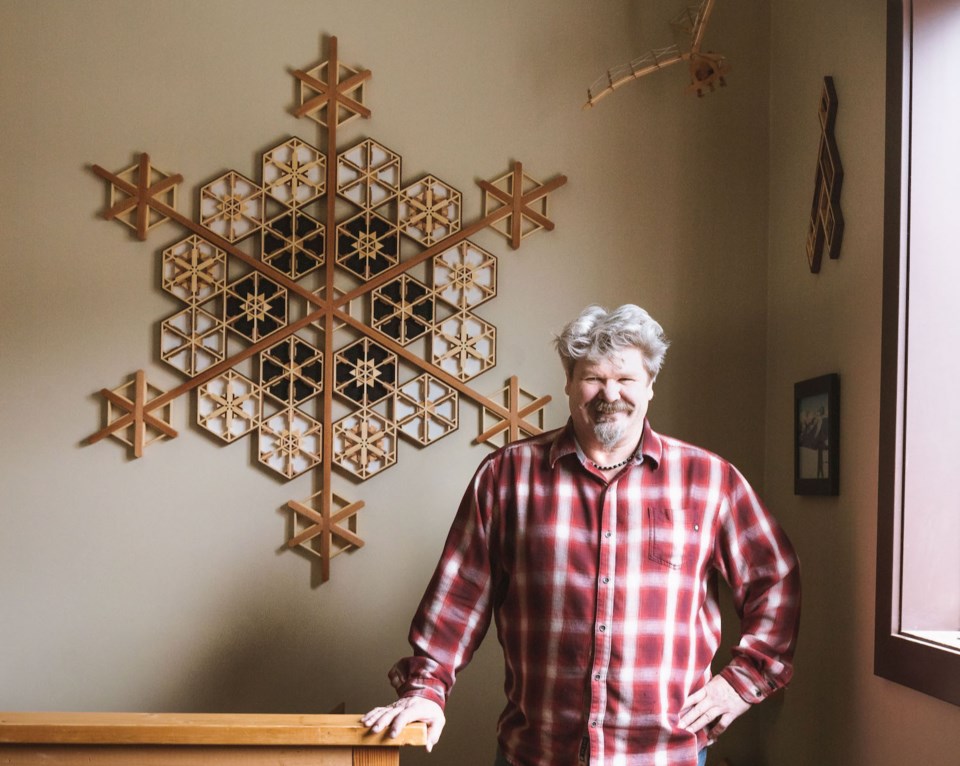When Rob LeBlanc first moved to Whistler in 1990, he wanted to spend as many days as possible in the mountains. That, of course, put him in the same boat as most who arrive here, and he wasted little time becoming a snowboard instructor. The New Brunswick native sought work as a labourer during summer months, which is where he developed his carpentry skills.
Two-and-a-half decades later, LeBlanc’s joints were beginning to wear out and he realized he couldn’t snowboard as much as before. That prompted a move to Vancouver and a stint constructing sets in the film industry until COVID-19 shut it all down.
Fortunately, LeBlanc had already discovered a new way to utilize his passion: wood art.
“I got to work with some really fancy stuff, building some really intricate sets, and it inspired me to figure out a way to work with wood for fun—hopefully for a career,” he says. “When I moved back up to Whistler, I realized: this is the land of snow and mountains. I should be making snowflakes and animals and bears and things like that, so that’s where I’ve focused for the last few years.
“When I moved here, I just wanted to snowboard and mountain bike and rock climb, but as I’ve gotten older, I’ve realized that there’s more to life than just those extreme physical pursuits. Art is really enriching.”
Reuse and repurpose
Sustainability is one of LeBlanc’s key concerns.
He appreciates the fact wood is a naturally-occurring resource, and he does not use any artificial chemicals to stain or paint his art. The vast majority of the wood he uses is somehow recycled from something else—the Re-Build-It and Re-Use-It Centres are a treasure trove of raw material, as are the inventories of local ski manufacturers, as well as canoe and kayak builders.
“I’m used to seeing old ski cabins being torn down and homes being renovated and wood being thrown out,” LeBlanc says. “In Whistler there’s a lot of stuff that gets turfed, and it just killed me to see this beautiful wood getting thrown out. So I started collecting some of it, and then I realized that I could make beautiful art out of this stuff.”
LeBlanc has participated in three shows over the course of the last calendar year, including the Anonymous Art Show and the Teeny Tiny Show, plus numerous farmers’ markets. He’s brushed shoulders with a lot of people along the way.
“The art scene in town here is very welcoming,” he remarks. “We all kind of support each other. We buy each other’s art. A lot of people who know me have come up to me at a farmers’ market and gone: ‘I didn’t know you make art!’ Then you start talking, and you find out that they’re doing something creative as well.”
‘Very zen-like’
LeBlanc still works in construction to help pay his bills. He has experience running job sites with more than 20 people looking to him for guidance, and figures he’s built more than a dozen multimillion-dollar luxury homes in the Sea to Sky corridor. Even so, he hopes to gradually transition into being a full-time artist.
“You kind of feel like an old-world craftsman, using little hand saws and doing [most] things manually—some machinery for a few things,” LeBlanc says. “The bulk of the effort that goes into making this art is very time-consuming, but it’s very zen-like. It’s relaxing, as opposed to using big saws and framing nail guns and working on a job site.”
Perhaps the most fulfilling thing LeBlanc has gotten to do is make things that hold some type of personal significance with his clients.
One of his more recent projects came courtesy of a woman who brought him wood left over from her great-grandparents’ shipping containers. He combined the old Egyptian wood with stuff from Whistler, and the resulting snowflake is on its way to be displayed in Sydney, Australia.
“By far, the most satisfaction I get is when I get to use material from a client’s past to create a piece of art that resonates with them both emotionally and aesthetically,” he explains. “It’s really neat when your art can tie together different people or places or events.
“You feel like you’re doing something more than just creating something to look at. You’re creating a memory and a touchstone. In my perfect world, that’s all I would be doing.”
Check out Leblanc’s portfolio at artworkarchive.com/profile/robert-e-leblanc.




